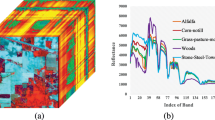Abstract
Recently, sparse representation-based classification (SRC), which assigns a test sample to the class with minimum representation error via a sparse linear combination of all the training samples, has successfully been applied to hyperspectral imagery. Alternatively, spatial information, which means the adjacent pixels belong to the same class with a high probability, is a valuable complement to the spectral information. In this paper, we have presented a new spectral-spatial-combined SRC method, abbreviated as SSSRC or \(\mathrm{S}^{3}\mathrm{RC}\), to jointly consider the spectral and spatial neighborhood information of each pixel to explore the spectral and spatial coherence by the SRC method. Furthermore, a fast interference-cancelation operation is adopted to accelerate the classification procedure of \(\mathrm{S}^{3}\mathrm{RC}\), named \(\mathrm{FS}^{3}\mathrm{RC}\). Experimental results have shown that both the proposed SRC-based approaches, \(\mathrm{S}^{3}\mathrm{RC}\) and \(\mathrm{FS}^{3}\mathrm{RC}\), could achieve better performance than the other state-of-the-art methods.










Similar content being viewed by others
References
Asif M (2008) Primal dual pursuit: a homotopy based algorithm for the dantzig selector. Master’s thesis, Georgia Institute of Technology
Benediktsson JA, Palmason JA, Sveinsson JR (2005) Classification of hyperspectral data from urban areas based on extended morphological profiles. IEEE Trans Geosci Remote Sens 43(3):480–491
Cai-Kou C, Yi-Ming Y, Jun S (2012) A fast sparse representation based classification. J Nanjing Univ (Nat Sci) 1:012
Candes EJ, Tao T (2005) Decoding by linear programming. IEEE Trans Inf Theory 51(12):4203–4215
Chang CI (2003) Hyperspectral imaging: techniques for spectral detection and classification. Kluwer/Plenum Academic Publishers, New York
Chen Y, Nasrabadi NM, Tran TD (2011) Hyperspectral image classification using dictionary-based sparse representation. IEEE Trans Geosci Remote Sens 49(10):3973–3985
Chen Y, Nasrabadi NM, Tran TD (2010) Classification for hyperspectral imagery based on sparse representation. In: 2010 2nd Workshop on Hyperspectral image and signal processing: evolution in remote sensing (WHISPERS), IEEE, pp 1–4
Dell’Acqua F, Gamba P, Ferrari A, Palmason J, Benediktsson J, Arnason K (2004) Exploiting spectral and spatial information in hyperspectral urban data with high resolution. IEEE Geosci Remote Sens Lett 1(4):322–326
Donoho DL, Tsaig Y (2008) Fast solution of-norm minimization problems when the solution may be sparse. IEEE Trans Inf Theory 54(11):4789–4812
Dópido I, Li J, Marpu PR, Plaza A, Benediktsson JA (2013) Semisupervised self-learning for hyperspectral image classification. IEEE Trans Geosci Remote Sens 51(7):4032–4044
Fauvel M, Tarabalka Y, Benediktsson JA, Chanussot J, Tilton JC (2013) Advances in spectral-spatial classification of hyperspectral images. Proc IEEE 101(3):652–675
Krishnapuram B, Carin L, Figueiredo MA, Hartemink AJ (2005) Sparse multinomial logistic regression: fast algorithms and generalization bounds. IEEE Trans Pattern Anal Mach Intel 27(6):957–968
Lee MA, Prasad S, Bruce LM, West TR, Reynolds D, Irby T, Kalluri H (2009) Sensitivity of hyperspectral classification algorithms to training sample size. In: Hyperspectral Image and Signal Processing: Evolution in Remote Sensing, (2009) WHISPERS’09. First Workshop on, IEEE, pp 1–4
Li J, Bioucas-Dias JM, Plaza A (2012) Spectral-spatial hyperspectral image segmentation using subspace multinomial logistic regression and markov random fields. IEEE Trans Geosci Remote Sens 50(3):809–823
Lu D, Weng Q (2007) A survey of image classification methods and techniques for improving classification performance. Int J Remote Sens 28(5):823–870
Manolakis D, Marden D, Shaw GA (2003) Hyperspectral image processing for automatic target detection applications. Linc Lab J 14(1):79–116
Natarajan BK (1995) Sparse approximate solutions to linear systems. SIAM J Comput 24(2):227–234
Plaza A, Benediktsson JA, Boardman JW, Brazile J, Bruzzone L, Camps-Valls G, Chanussot J, Fauvel M, Gamba P, Gualtieri A et al (2009) Recent advances in techniques for hyperspectral image processing. Remote Sens Environ 113:S110–S122
Prasad S, Bruce LM (2008) Overcoming the small sample size problem in hyperspectral classification and detection tasks. In: IEEE International Geoscience and Remote Sensing Symposium, 2008. IGARSS 2008, IEEE, vol 5, pp V-381
Rand RS, Keenan DM (2003) Spatially smooth partitioning of hyperspectral imagery using spectral/spatial measures of disparity. IEEE Trans Geosci Remote Sens 41(6):1479–1490
Rother C, Kolmogorov V, Blake A (2004) Grabcut: Interactive foreground extraction using iterated graph cuts. ACM Trans Graph 23(3):309–314
Sami ul Haq Q, Tao L, Sun F, Yang S (2012) A fast and robust sparse approach for hyperspectral data classification using a few labeled samples. IEEE Trans Geosci Remote Sens 50(6):2287–2302
Soille P (2003) Morphological image analysis: principles and applications. Springer, New York
ul Haq QS, Shi L, Tao L, Yang S (2010) Hyperspectral data classification via sparse representation in homotopy. In: 2010 2nd International Conference on Information Science and Engineering (ICISE), IEEE, pp 3748–3752
Wright J, Yang AY, Ganesh A, Sastry SS, Ma Y (2009) Robust face recognition via sparse representation. IEEE Trans Pattern Anal Mach Intel 31(2):210–227
Zhang H, Zhang Y, Huang TS (2013) Simultaneous discriminative projection and dictionary learning for sparse representation based classification. Pattern Recognit 46(1):346–354
Acknowledgments
This work was jointly supported by grants from National Natural Science Foundation of China (61271022), Guangdong College Excellent Young Teacher Training Program (Yq2013143), Shenzhen Scientific Research and Development Funding Program (JCYJ20140418095735628, ZDSY20121019111146499, JSGG20121026111056204, JCYJ20120817163755063), and National Basic Research and Development Program (2012CB719905). All correspondence should be addressed to Associate Professor Jiasong Zhu.
Author information
Authors and Affiliations
Corresponding author
Additional information
Communicated by Y.-S. Ong.
Rights and permissions
About this article
Cite this article
Jia, S., Xie, Y., Tang, G. et al. Spatial-spectral-combined sparse representation-based classification for hyperspectral imagery. Soft Comput 20, 4659–4668 (2016). https://doi.org/10.1007/s00500-014-1505-4
Published:
Issue Date:
DOI: https://doi.org/10.1007/s00500-014-1505-4




